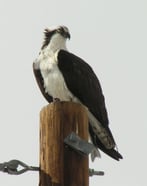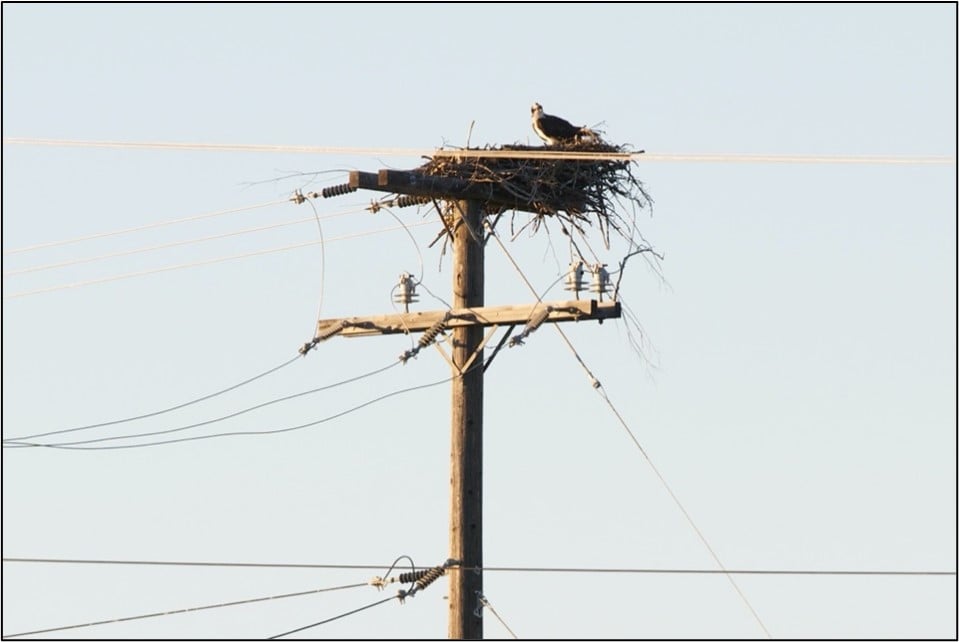If you have ever driven along a river, the ocean, or a large lake and come across a massive, imposing, messy stick nest on a distribution or transmission power line, chances are you are looking at a nest of an osprey. These large raptors (birds of prey) with a global distribution are well-adapted to specialize on small to large sized fish. They nest along fish-bearing waterbodies - historically in the tops of broken tree snags, but as power poles became common across the landscape, they became valuable real estate for nesting osprey, particularly those near water.
Hazards Caused by Osprey Nests on Power Poles
Osprey may reuse their nests year after year, adding to them during each spring renovation, leading some to become hundreds of pounds. As power lines were not designed to support such a heavy burden, they can become structurally compromised as a result. Further, if sticks used in nest-building cross phases these nests can become a severe electrocution hazard to the birds, pose a serious risk to the integrity of the power system (see photo), and can even lead to grass fires and substantial property damage. Osprey are extremely loyal to their natal area (where they hatched and were raised) and will return to the same general area when it is time to raise chicks of their own; additionally, some speculate that those raised on, and fledged from a power line nest may also seek out power lines for their future nests. Raptors and their nests are legally protected in most jurisdictions around the world.
Protecting Osprey and Preventing Power Outages
 All these factors combined provide unique challenges for electric utilities in spring, and as a consequence, osprey nest management for many utility companies has become an annual part of doing business. If just a few sticks are dropped (and if local wildlife legislation permits), sticks can sometimes be cleared off before they form a nest. (Note: it is critical to understand the law in your jurisdiction.) However, once nests are constructed, they are legally protected in many jurisdictions. Newly discovered nests must first be assessed to determine if in fact they pose a risk to the birds or the integrity of the system; in many cases, particularly on larger transmission towers, nests are well enough away from equipment that they can be accommodated as is, or just get occasional trimming. Those that truly pose one of the above-mentioned hazards can, depending on the stage of the nest and with wildlife authority permission, be moved to an artificial nesting platform erected nearby by the utility (often this can be done at the end of the nesting season, in preparation for the following year).
All these factors combined provide unique challenges for electric utilities in spring, and as a consequence, osprey nest management for many utility companies has become an annual part of doing business. If just a few sticks are dropped (and if local wildlife legislation permits), sticks can sometimes be cleared off before they form a nest. (Note: it is critical to understand the law in your jurisdiction.) However, once nests are constructed, they are legally protected in many jurisdictions. Newly discovered nests must first be assessed to determine if in fact they pose a risk to the birds or the integrity of the system; in many cases, particularly on larger transmission towers, nests are well enough away from equipment that they can be accommodated as is, or just get occasional trimming. Those that truly pose one of the above-mentioned hazards can, depending on the stage of the nest and with wildlife authority permission, be moved to an artificial nesting platform erected nearby by the utility (often this can be done at the end of the nesting season, in preparation for the following year).
In addition to platforms, nest deterrents should be added to the original target power pole to prevent future nesting attempts. It is important that platforms and deterrents are used in conjunction; if only one of these tools is used, the management effort will likely fail. Given the inherent persistence of these birds, a solution that finds a way to accommodate them, while maintaining the integrity of the power system, will ultimately be a successful one.

 All these factors combined provide unique challenges for electric utilities in spring, and as a consequence, osprey nest management for many utility companies has become an annual part of doing business. If just a few sticks are dropped (and if local wildlife legislation permits), sticks can sometimes be cleared off before they form a nest. (Note: it is critical to understand the law in your jurisdiction.) However, once nests are constructed, they are legally protected in many jurisdictions. Newly discovered nests must first be assessed to determine if in fact they pose a risk to the birds or the integrity of the system; in many cases, particularly on larger transmission towers, nests are well enough away from equipment that they can be accommodated as is, or just get occasional trimming. Those that truly pose one of the above-mentioned hazards can, depending on the stage of the nest and with wildlife authority permission, be moved to an artificial nesting platform erected nearby by the utility (often this can be done at the end of the nesting season, in preparation for the following year).
All these factors combined provide unique challenges for electric utilities in spring, and as a consequence, osprey nest management for many utility companies has become an annual part of doing business. If just a few sticks are dropped (and if local wildlife legislation permits), sticks can sometimes be cleared off before they form a nest. (Note: it is critical to understand the law in your jurisdiction.) However, once nests are constructed, they are legally protected in many jurisdictions. Newly discovered nests must first be assessed to determine if in fact they pose a risk to the birds or the integrity of the system; in many cases, particularly on larger transmission towers, nests are well enough away from equipment that they can be accommodated as is, or just get occasional trimming. Those that truly pose one of the above-mentioned hazards can, depending on the stage of the nest and with wildlife authority permission, be moved to an artificial nesting platform erected nearby by the utility (often this can be done at the end of the nesting season, in preparation for the following year). 

